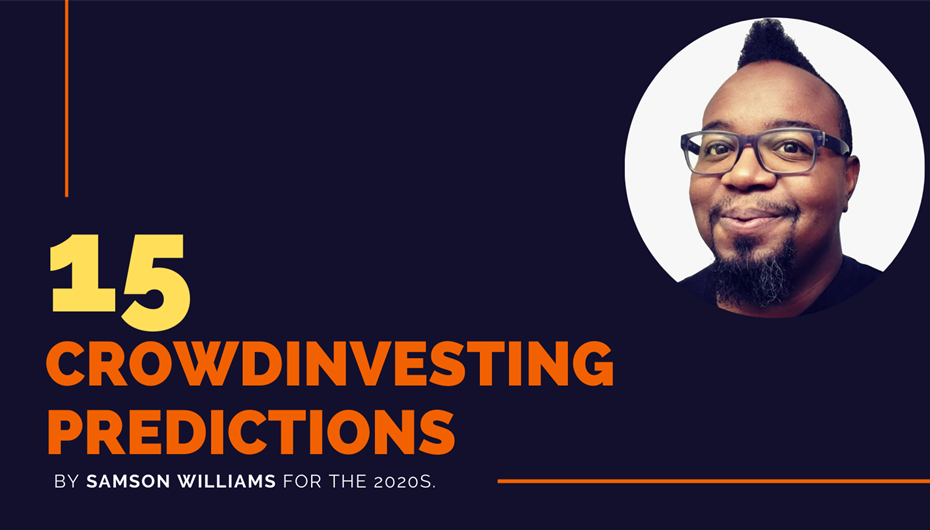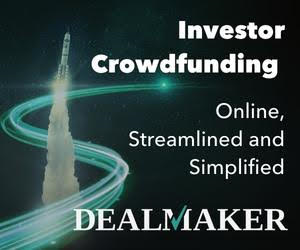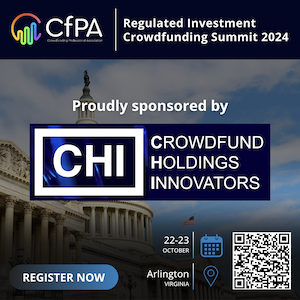Hello Beautiful People!
For those of you who have never met me my name is Samson Williams and I’m the President of the Crowdfunding Professional Association. I came by this honor by an odd set of circumstances that allows me to stand on the shoulders of everyone who worked so diligently to birth the Investment Crowdfunding industry. I say this because I am in no way responsible for the success of the industry but man oh man am I a fan. In that regard I am sharing my vision and thoughts on where the CrowdInvesting* industry will be by 2030. Are my predictions 100% correct? A crazy, wild-eyed scientist and a kid borrowed my time machine so I dunno. Time will tell. But as you read this just keep in mind, “The hardest part of anyone’s overnight success is the first 10 years.” Title III of the JOBS Act turns five years old on May 16, 2021 so the retail crowdfunding industry isn't even in kindergarten yet. What follows are insights into where the industry will be by the time it turns into a teenager.
Disclaimer - George Pullen and I are the founders of a weird little, DC based Think Tank called Milky Way Economy. Through the Milky Way Economy we make moon-shot investments. As such, we’re the lead investors in Brite.us - Investment Crowdfunding done Brite and investor #17ish out of 30ish in Crush Capital who are launching the RegA+ platform/show “GoingPublic.com”. So anything I say should be viewed through the lens of someone so fanatical about the future of crowdfunding that he puts his money where his mouth is.
* I use crowdinvesting and investment crowdfunding interchangeably. While the terms are synonymous I want to be clear that when I say “crowdfunding” I’m not talking about donations or rewards crowdfunding but investing/investment crowdsourcing.
Investment Crowdfunding in 2030 - 15 Predictions for the Industry.
1. Every FINRA approved platform will also be a media company. By 2030, media companies will dominate the crowdfunding industry. Meaning, if your platform doesn’t also offer some engaging / entertaining content, you’ll be obsolete. At the end of the day, the principle of crowdfunding hinges on a very simple premise, “Crowdfunding works best with a crowd.” If you’re currently not a media company your options are as follows:
- You will be acquired by a media company.
- You’ll pay media companies and other platforms (FB, Twitter, etc…) around 50% of your revenue to advertise your platform.
- You’ll pay Issuance licensing fees to license their proprietary tech that makes it possible for consumers / the public / retail investors and the audience to invest in crowdfunding deals in real-time on their mobile devices, smartTVs, and voice activated devices (e.g.: Hey Alexa, Hey Google, invest $500 in the deal I’m listening to on GoingPublic.com”)
Note - I don’t actually know if Issuance / GoingPublic is planning on doing that. I’ve never looked at their investor deck, pitch deck or talked to the Crush Capital / Going Public team. But I do stalk @DarrenMarble on Twitter and understand the power of entrepreneurship, combined with Natural Language Processing, KYC/AML and digitalization. Also, updates to the 1933 Securities Act, that the Crowdfunding Professional Association advocates for, make using digital technology easier, or rather, in many instances, possible (#blockchain / #tokenization). Hence why the idea of investing in a company by telling your always-listening-device “Hey Siri, invest $1000 into this deal” is neither regulatoraily or technologically far-fetched as it may have been even a year ago. There is an American’s with Disabilities Act (ADA) requirement, Web Content Accessibility Guidelines WCAG 2.0 AA 2.1 AA, that may mandate all crowdfunding portal webpages to be voice activated/navigable. Again, we’re looking at the industry in 2030 so don’t freak out just yet. But note --- it is coming.
The first prediction is actually a pretty big fish to swallow. I understand some may vehemently disagree. That's ok. The future is often scary but it comes regardless. As you consider the examples above, think of an aging population, potential ADA requirements and the fact that older people have the most money to invest and are the largest demographic of the group defined by the term “Accredited Investor”. FYI - the medium age of Accredited Investors is between 60-64. Where does the money reside in the crowdfunding industry today and in 2030? Likely with older investors who consume your digital offerings, via digital media, on your show, podcast, social media, streaming thing or branded TikTok page.
2. Crowdfunding transaction fees will be 2.5% by 2030...probably by 2024 actually.
March 24, 2008 was my first day at Fannie Mae. I was hired as an emergency management consultant. My first day on the job I didn’t even know what Fannie Mae did. Which worked out well, cause it turned out they didn’t know what they did either. From 2008 to 2016 I learned a lifetime’s worth of capital markets and mortgage banking stuff as Fannie Mae’s Crisis Manager and then Baby Chief of Staff for the Operations & Technology Executive Office. When I wasn’t busy babysitting Executive egos I learned some very interesting data points, such as the following:
18.45%. In October 1981 the 30-year fixed rate mortgage rate was 18.45%. This was the highest rate for mortgages in the last 40 years. You can see them all here courtesy of Freddie Mac: http://www.freddiemac.com/pmms/pmms30.html
Why this is important is because right now the cost of raising capital on the 75+ (as of Feb 20, 2021) FINRA approved portals varies from 5% to 14%; plus perhaps mandatory marketing fees, a “success fee” and equity in the deal of the company. By 2030 that fee will average around 4.5% with some offering it as low as 2.5%. I know. I know, currently there are no profitable platforms. It costs about $300k to stand up a portal and about $2M a year if you actually want it to work. However, at the end of the day with digitalization, the mass-effect of turning social networks into social capital, via social media companies (a la GoingPublic.com and your business after you read this) the cost to raise funds will drop. What will make this possible is called an Innovation Stack. Rocket Mortgages did it in the mortgage industry (current mortgage rates are about at 2.75% for a 30 year fixed mortgage), Square did it for the credit card processing industry and LUV (SouthWest Airlines clearly already aware of good marketing and brand) did it in the airline industry. They all offer their industry setting services, at ridiculously low industry setting rates.
In short, the 2.5% cost to raise funds on portals will be achieved by whomever builds an innovation stack that can service the smallest, most capital hungry Issuers, looking to raise $25k to $250k in capital.
That is probably going to be Brite.us. But remember, Milky Way Economy is their lead investor and so anything I say is inherently biased. How will they do that? More importantly, how could you and the crowdfunding industry do that? The short answer is Brite.us has turned all the messy middle and back office work associated with equity crowdfunding into Excel. No business owner or entrepreneur likes using Excel but they all know how and don't care much about what is happening under the hood (please send any comments around how much you love using VBA, Loops, or VLookUps to George @Pullen4Maine to continue that debate). In the same way no business owner or entrepreneur likes raising money, raising money isn't their business, their business is their business. When your customers become “investomers” at the click of a button the revolution will be complete.
3. Easy to use platforms. Portals will focus on Human Centered Design, automation & UX; while baking compliance into the back-end.
4. Accessible to everyone (web, mobile, voice multiple languages, ADA compliant).
5. Easy to share with their friends, via word-of-text.
6.To generate the high volume needed to provide low cost crowdfunding services.
7. A platform needs to process 100M in deal flow at 2.5% just to keep the doors open.
- This seems like an impossible number considering that the entire industry only raised $214M in 2020. However, the retail crowdfunding industry isn’t even old enough to go to kindergarten. By the time Title III of the JOBS Act hits Middle School we (Milky Way Economy) anticipate there will be over a dozen portals who do $100M a year in deal flow. For instance, Milky Way Economy is betting that GoingPublic.com will do $100M in 2022 alone but they’re a RegA+, so we don’t count them in the RegCF bucket.
8. Low cost requires a direct sales force.
9. Advertising is required so that the public and customers know what the sales person is selling in order to invest into deals.
- 99% of potential investors currently think “crowdfunding” means donations. But by 2025 that education curve will be greatly reduced as the first Investment Crowdfunding unicorns are birthed.
10. Portal’s key products will be the $250k raise, which comes with the industry standard 2.5% fee.
11. In order to provide the $250k raise, Portals must simplify the onboarding / underwriting process, via automation (think RocketLoans / TurboTax).
12. Stand up brick & mortar locations, in key entrepreneur centers.
13. Brick & mortar locations, in a digital age, to enable Issuers and Investors to talk to other people about their crowdfunding needs.
- The innovation here is in person-customer service in the crowdfunding industry, which sounds crazy until you do it.
14. Partnerships with small business loan providers, who extend revolving credit (CFDIs, Credit Unions, FinTech banks, etc…).
15. “Fractional ownership” of Portals a la a “franchise” model to drive traffic and increase awareness of your portal.
- Yes. I know there are no franchises in the crowdfunding industry. There are a number of regulatory reasons why they don’t currently exist. But...imagine if this was possible? That imagination is what the industry is building towards in 2030.
The top and middle of the crowdfunding industry is rife with portals competing for 5% - 14% of fees. The future is with whomever can automate the process to charge a 2.5% or less crowdfunding fee, similar to credit card processings fees.
These are some predictions for what the crowdfunding industry will look like in 2030. As at the bottom of startup capital there are no competitors, as who would be foolish enough to try to offer a product that low, when everyone in the industry knows that is impossible? A media company, that's who.
Conclusion - Join the CfPA
As the industry evolves the Crowdfunding Professional Association will continue to advocate and push for the regulatory innovations that will make the future of the industry possible. I’m encouraging everyone reading these predictions to join the CfPA.org and be part of the exponential growth of this industry. The CfPA needs to hear EVERYONE’s voice so that as an industry we can rise to the occasion and shape how the future capital needs of businesses will be met.
Funding Portals - If you’re a Funding Portal, join as a corporate member and provide the CfPA the educational content you're developing so we can share it with the public to help lower your and the industry’s customer acquisition costs. Feel free to sponsor some educational events as well.
Issuers - There are 70+ crowdfunding portals. I anticipate by the end of year there will be over 110 to choose from. Pick the one that works best for you and let the CfPA know if there are any regulatory or compliance issues that we can address to the SEC, FINRA or Congress on your behalf.
Investors - Over 60% of the investors in RegCF campaigns are already accredited. Keep it up. Because while the “micro investor” ($1k to $2K) will dominate the 2020s, accredited investors are key to helping build momentum and demonstrating their sophistication by investing into both early stage startups and established businesses.
Community - We need you! Join the CfPA as an individual member. The CfPA is always looking for fresh minds, generous souls, diverse perspectives--current and future leaders bear the mantle of democratizing access to capital. Join us! All are welcome!
Until next time, see you in the future and thanks for sharing this article with your community!
Samson Williams
President, CfPA
Investor - Brite.us & GoingPublic.com
Register for FREE to comment or continue reading this article. Already registered? Login here.
2


